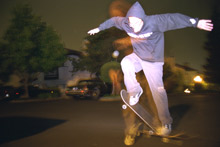RIP.MIX.BURN.BAM.PFA

Image: Valéry Grancher: 24h00, 1999
interactive Web project sponsored by BAM
Image and text source: BAM/PFA
RIP.MIX.BURN.BAM.PFA celebrates the cultural and artistic practice of remix, inviting guest artists to “rip, mix, and burn†elements from two digital-media works in the museum’s collection—Ken Goldberg’s Ouija 2000 and Valéry Grancher’s 24h00 (both 1999)—resulting in new artistic creations. Drawing from the open-source software tradition, with the permission of artists Goldberg and Grancher, the remix artists may alter or revise original code or media files from the source works, or they may choose to take a more conceptual route, remixing some of the methods or behaviors of the originals into their own new works. Ouija 2000 and 24h00 will be exhibited along with new works by Michael Joaquin Grey, Alison Sant, Jonathon Keats, and Nathaniel Wojtalik and Iris Piers. On view in BAM’s Bancroft lobby and stairwell gallery, the artworks will also be available via the exhibition website at bampfa.berkeley.edu/ripmixburn for the public to download and remix.
Remix as artistic practice has a long history, with roots in appropriations like Marcel Duchamp’s mustachioed postcard of the Mona Lisa and Andy Warhol’s images of Campbell’s soup cans, works that question the nature of originality. Because digital media are easily replicated, artists can directly use the materials of others’ original works—code, images, sounds—for new purposes. While it’s hard to “remix†a painting without destroying the original, digital media allow artists to create a close relationship between the source work and their own, one that integrates the craft and (sometimes unintended) nuances of the original.
The world of digital technology also has a history of the remix. The Internet has allowed people to illegally download commercial and creative works from music to movies, but it has also allowed a parallel practice to evolve, in which programmers share open-source code with each other for a larger public good. The art world mirrors this history of generosity in works like Félix González-Torres’s Candy Spill series, in which the artist piled candies on the gallery floor, inviting visitors to take them home and thus participate in a send-up of rigid notions about the “immutable†artwork.
RIP.MIX.BURN.BAM.PFA is a cultural experiment that applies the advantages of digital media and the spirit of open-source generosity to museum permanent collections. The artworks in the exhibition are highly original and each stands on its own, yet each is also a link in a long artistic chain of giving and taking.
Richard Rinehart
Digital Media Director and Adjunct Curator
Lascia un commento
You must be logged in to post a comment.








